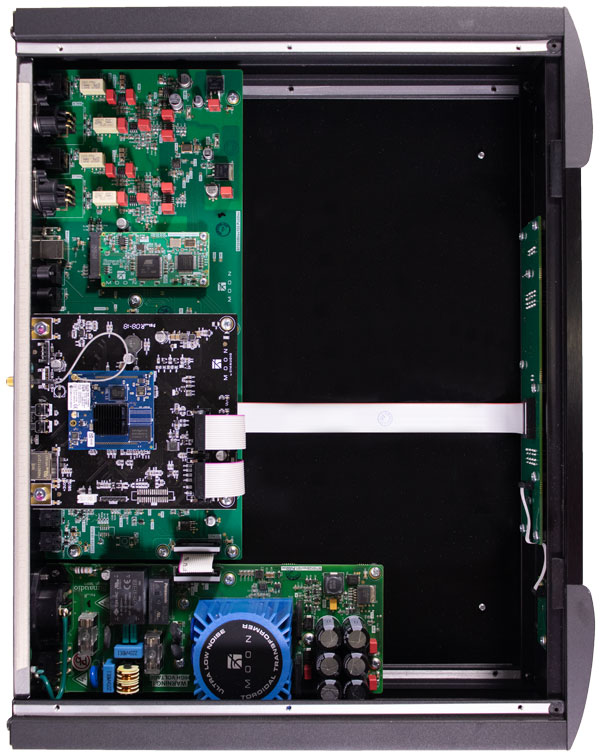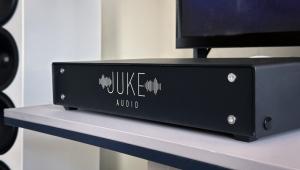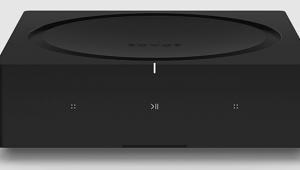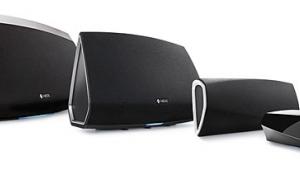Simaudio Moon 280D Streaming DAC Review Page 2
Setup
The Moon 280D's owner's manual states that it features a "rigid" chassis construction to minimize the effect of external vibrations. Whoever wrote that wasn't at all kidding. Examining the review sample, the aluminum chassis panels were unexpectedly thick, and it seemed to weigh more than its advertised 16 pounds. It's also undergirded by Simaudio's proprietary feet, which are constructed of aluminum, plastic, and foam.
Pawing the Moon 280D, I also noticed that its front panel's cheeks, which at first appeared to be made of aluminum like the rest of the chassis, were in fact made of a polycarbonate plastic. But considering the 280D's price, I can't blame Simaudio for cutting a corner or two. Plastic cheeks or not, how the company produces a component of such high build quality in its Canadian factory for $3,000 is a mystery to me.

Preparing the Moon 280D for blastoff, I downloaded the USB HD DSD driver to my Microsoft Windows-based laptop. (This step is unnecessary if connecting a Mac computer and, in any event, is only required to use the 280D's USB input.) I also downloaded the robust and well-designed Moon MiND controller app to my iPhone and iPad mini.
Next, I screwed in the 280D's Wi-Fi antenna and connected an Ethernet cable to it from my router. I then ran a pair of interconnect cables from the 280D to System Audio Saxo 5 powered bookshelf speakers, which in turn passed the audio signal to a JL Audio Dominion d110 subwoofer. (Simaudio recommends using the 280D's balanced XLR outputs, but I used single-ended RCA since that's the only connection type the Saxo 5 speakers accept.) From there, I powered up the Moon 280D and opened the Moon MiND controller app, which among other things, asked me to enter my Wi-Fi password and Qobuz account info. Overall, I encountered no setup issues and the 280D operated flawlessly during my time with it.
While I briefly tried each of the Moon 280D's inputs, I primarily used the USB port to play digital music files stored on my laptop, the network connection to stream Qobuz an internet radio stations, and a coaxial input for a Sony UBP-X800 Blu-ray disc player (set up to convert movie soundtracks to 2.0 PCM format).
Performance
Alternating between the Moon 280D's USB and network inputs, I started my listening with "Willow Weeps for Me," from Ben Webster Plays Ballads (24-bit/96kHz FLAC, Qobuz). Webster's tenor saxophone came across as rich, warm, and mellow. Dynamic swings also sounded smooth and liquid rather than coarse and stepped.
Listening next to "Dream Gypsy," from Bill Evans and Jim Hall's Undercurrent (16/44.1 FLAC), Evans' piano notes displayed excellent weight and density. Similarly, on "Oxygene 2 (JMJ Rework of Kosinki Remix)," from Jean Michel Jarre's Welcome to the Other Side (24/48 FLAC, Qobuz), the synthesized riffs were solidly formed, and bass beats had excellent punch and transient snap. In fact, no matter what I played, leading edges sounded clear and crisp without being overly sharp.
The Moon 280D's dense sound was accompanied by an exceptional bass foundation. When I played Stravinsky's sensational "Sacrificial Dance," from Stravinsky, Stokowski, the Rite of Spring/Bach Transcriptions, with Yannick Nezet-Seguin conducting the Philadelphia Orchestra, (16/44.1 FLAC, Qobuz), the subtle variations in rumbling timpani sounds were cleanly reproduced. Bass drum attacks sounded extended and powerful, with the 280D delivering a dynamic presentation of percussive strikes.
The Moon 280D also produced a deep soundstage with solidly rooted aural images. Listening to Muddy Waters' "Tiger in Your Tank," from Muddy Waters at Newport 1960 (16/44.1 FLAC, Qobuz), the guitarist's half-brother and pianist Otis Spann was clearly positioned on the stage's far left, somewhat directly in front of drummer Francis Clay. To the right was Waters, who was noticeably in front of electric guitarist Pat Hare and bass player Andrews Stephens.

With "I Got My Brand on You," from the same Muddy Waters album, the Moon 280D presented a layered front- to-back image of audience handclaps, with some sounding very much near the stage. Also on this track, the sound of Hare's guitar as he walked to the stage's far right seemed to emanate from a foot or more beyond the right speaker.
To wrap things up, I watched the action-thriller Extraction and could feel the sound of machine gun rounds being fired in my chest. The 280D also delivered the goods in a high-speed car chase, clearly reproducing the sonic details of a car being overturned and gunmen shooting out the windows of a bus.
Competition
Does the Moon 280D slay its competitors on every criterion? An Auralic Altair G1 digital audio streamer ($2,889) I recently listened to impressed me with its timbral delineation, a factor that will be particularly important to classical music fans. And spending more on Lumin's T2 network music player ($4,500), will get you a bit more of every- thing in terms of overall sound quality and features. Still, the 280D in my estimation easily rubs shoulders with the very best network music players at its price level.
Conclusion
Simaudio's Moon 280D wasn't designed with a kitchen-sink approach. If you're looking for a network music player with a front panel display, volume control, onboard room correction, HDMI switching, phono preamp, headphone output, and maybe a Star Trek-like transporter that beams people and objects to far-off galaxies, I'd suggest you look elsewhere. What the 280D does do is convert digital sources to analog and stream music from local sources and online music services with a high level of fidelity. Add to that its tank-like build quality, made in North America boasting rights, and lengthy ten-year warranty, and it's any easy recommendation for anyone who values quality over quantity.





























































